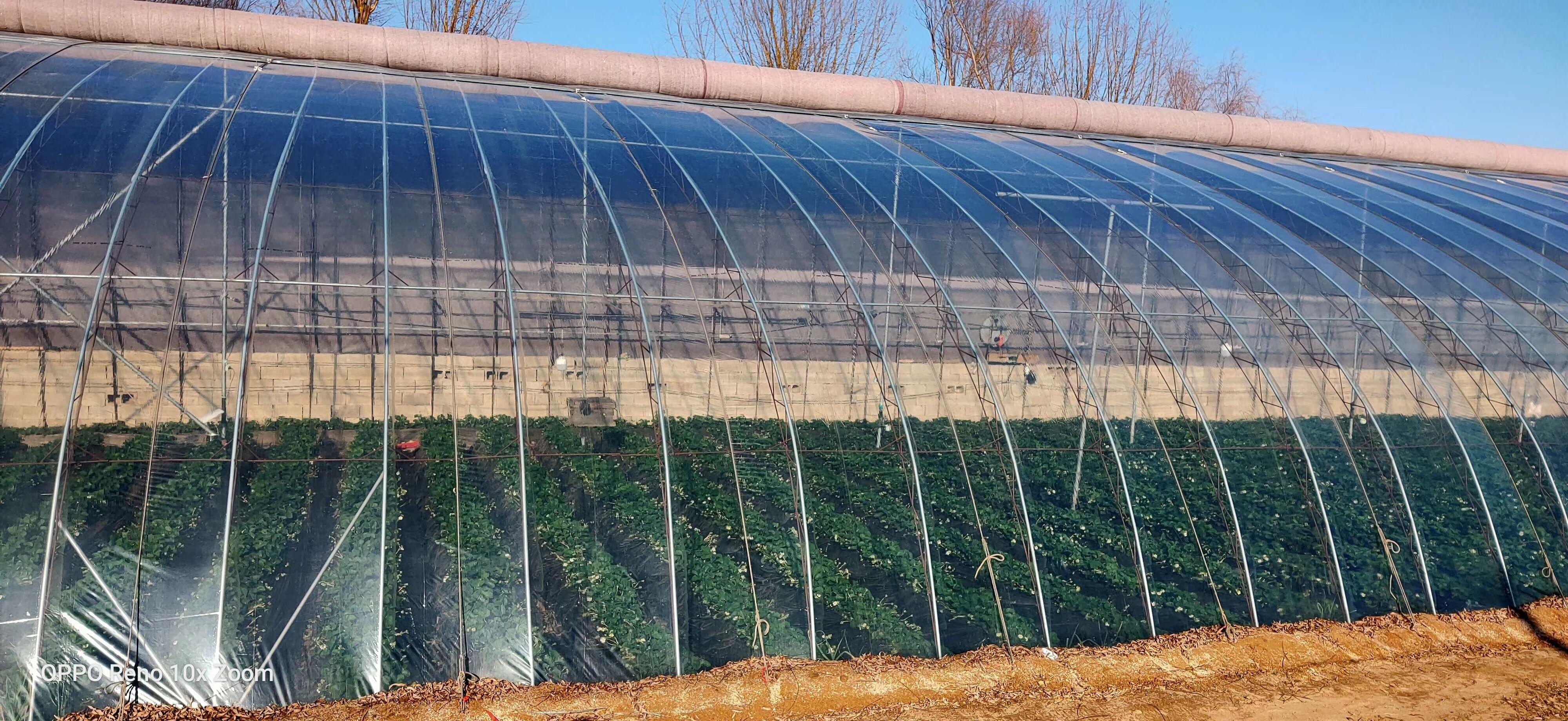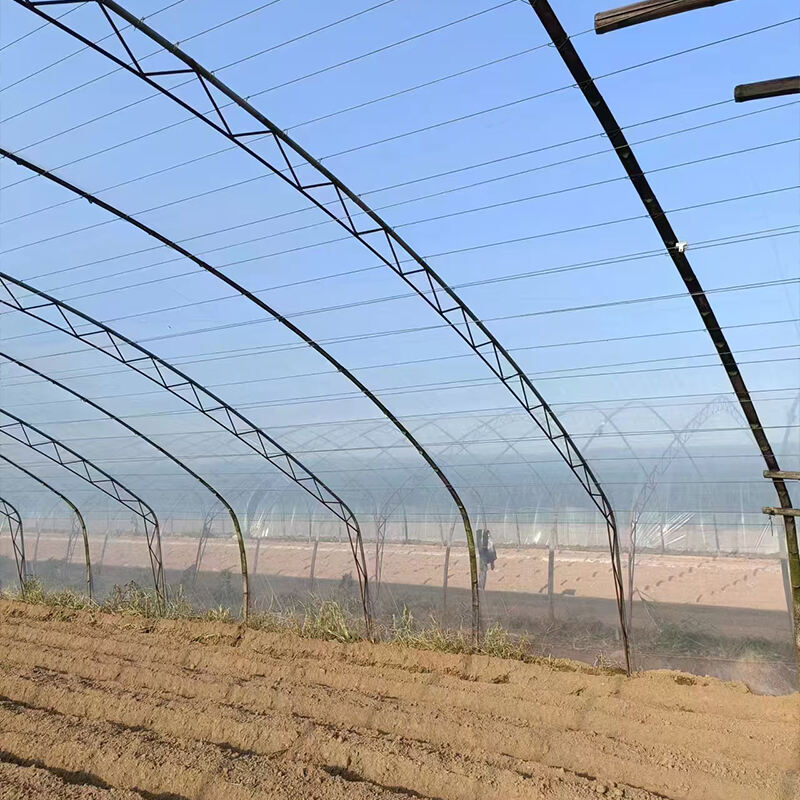고급 농업 필름을 사용한 토양 태양열 소독
태양열 소독 필름이 어떻게 열을 갇혀 화학물질을 대체하는가
토양 태양열 처리는 해충을 제거하기 위해 열을 이용하는 방식으로, 농부들은 투명하거나 어두운 색의 농업용 비닐을 땅 위에 깔아 사용합니다. 이러한 비닐을 축축한 토양 위에 덮으면 온실 효과와 비슷한 환경이 조성되어 토양 온도가 평소보다 훨씬 높아지게 됩니다. 연구에 따르면 이러한 비닐 아래의 토양 온도는 주변 온도보다 약 20℉(섭씨 약 11℃)까지 상승할 수 있으며, 이러한 고온은 화학 약품 없이도 많은 해충과 병원균을 제거할 수 있습니다. 이 기술을 도입한 농부들은 제초제나 살충제 사용량을 줄일 수 있어 결과적으로 토양 건강을 개선하는 데 도움이 됩니다. 비닐로 인해 발생하는 따뜻한 환경은 미세한 뿌리 선충류나 잡초가 자라지 못하게 막아, 농업에서 해충을 관리하는 친환경적인 대안이 될 수 있습니다.
열 소독의 환경적 이점
농업용 필름을 이용한 토양 태양열 소독은 농부들에게 골칫거리인 토양 전염성 병원균을 제거함으로써 실제적인 환경적 이점을 제공합니다. 재배자들이 합성 화학물질에 의존해 해충을 방제하는 것을 멈추면 오히려 장기적으로 토양이 건강해지고 밭의 생물다양성이 증가합니다. 화학물질 사용을 줄이는 것은 농장의 지속 가능성을 높이며, 이는 요즘 여러 국가들의 환경 정책과도 잘 부합됩니다. 이 방법을 시도해 본 농부들은 단 한 시즌만으로도 작물 수확량과 전체적인 토양 상태가 눈에 띄게 개선된 것을 경험했습니다. 이 친환경 접근법이 가치 있는 이유는, 주변 수원으로의 화학물질 유출로 인한 문제에 덜 취약한 농지를 만드는 동시에 생태계 보호에도 기여하기 때문입니다.
무산소 농업 필름 기술을 활용한 사일리지 보존
사일리지랩 산소 장벽의 과학적 원리
혐기성 Ag 필름 기술은 공기가 들어가지 않도록 특수 플라스틱 덮개를 사용하여 건초사일리지를 신선하게 유지하는 데 큰 역할을 합니다. 산소가 필름을 통과할 수 없게 되면 건초사일리지가 빨리 상하지 않고 보다 효과적으로 발효됩니다. 연구에 따르면 우수한 산소 차단 기술은 사일리지의 유효 저장 기간을 훨씬 연장하면서 동물에게 필요한 중요한 영양소를 유지할 수 있습니다. 이러한 플라스틱 포장을 사용하는 농부들은 이제 화학적 보존제에 크게 의존하지 않아도 되어 사료에 사용되는 화학물질을 줄일 수 있으며 시장에서 경쟁력 있는 고품질 제품 생산이 가능해졌습니다. 최근 낙농장 조사에 따르면, 이 새로운 포장 기술로 전환한 농장에서는 사료의 낭비가 줄어들고 가축 무리의 전반적인 건강 상태가 개선되는 등 실제적인 성과를 거두고 있습니다.
개선된 사료를 통해 가축 영양 강화
좋은 품질의 건초는 가축 건강과 생산성에 매우 중요하다. 건초를 적절히 포장하면 중요한 영양소가 손실되지 않도록 보존할 수 있다. 혐기성 농업 필름을 사용하는 농민들은 전반적으로 훨씬 더 나은 조사료 품질을 경험하고 있다. 단백질 함량이 더 높게 유지되며 가축이 실제로 활용할 수 있는 에너지 또한 증가한다. 가축 영양 전문가들은 고품질 건초를 급여할 경우 동물의 체중 증가율과 번식 성적이 실제로 개선되는 것을 확인했다. 이러한 현대적인 보존 기술을 사용함으로써 얻을 수 있는 또 다른 큰 이점은 저장 중 품질 저하에 대한 우려 없이 사료를 연중 안정적으로 확보할 수 있다는 점이다. 이는 계절과 관계없이 가축이 충분히 먹을 수 있음을 의미하며, 이는 동물의 전반적인 상태에 큰 차이를 가져온다.
해충 관리 및 작물 품질을 위한 색상 멀치 필름
곤충을 방해하기 위한 광스펙트럼 조작
다양한 색상의 멀칭 필름은 빛이 식물에 도달하는 방식을 바꿔 자연적으로 해충을 관리하는 새로운 방법으로 주목받고 있습니다. 농민들이 밭에 이러한 색이 있는 플라스틱 필름을 깔면 작물에 도달하는 빛의 종류가 바뀌게 됩니다. 특정 색상은 해로운 해충을 쫓아내면서 동시에 유익한 곤충들을 유인하는 효과가 있는 것으로 보입니다. 연구에 따르면 노란색은 벌과 같은 수분 매개체를 끌어들이지만 진딧물과 깍지벌레는 멀리하게 합니다. 녹색은 특정 종류의 딱정벌레를 억제하는 데 효과적입니다. 이는 농민들이 더 이상 과도하게 농약을 살포할 필요가 없음을 의미하며, 이는 환경과 농산물을 섭취하는 사람들에게 해로운 화학물질 사용을 줄이는 데 기여합니다. 연구에서는 또한 어떤 해충이 문제를 일으키는지에 따라 올바른 색상을 선택하는 것이 매우 중요하다는 점을 강조하고 있습니다. 농업인들은 멀칭 필름의 색상을 자신들이 직면한 구체적인 해충 문제에 맞춤화할 경우 수확량이 개선된다고 보고하고 있으며, 이는 기존 해충 방제 방법에 대한 점점 더 널리 채택되고 있는 대안이 되고 있습니다.

반사 표면을 통한 과일 풍미 프로필 향상
반사 멀치는 과일의 맛에 큰 차이를 만든다. 이는 햇빛 노출를 조절하고 식물 주변의 온도를 안정적으로 유지하는 데 도움을 주기 때문이다. 농민들이 이러한 특수한 멀치 소재를 포설할 때, 실제로 과일 표면에 도달하는 빛의 입사각을 개선시키는 효과가 있다. 연구에서는 이러한 반사 면 위에서 재배된 과일이 일반적으로 더 높은 브릭스(Brix) 수치를 보이는 것으로 나타났으며, 이는 곧 더 많은 당도와 더 달콤한 맛을 의미한다. 시장 조사에서는 소비자들이 반사 멀치 처리된 재배 침대에서 자란 과일을 더 선호하는 경향이 꾸준히 나타나고 있다. 이는 과일이 식물 전체에서 보다 균일하게 발달하기 때문이다. 농민들이 현장 테스트를 진행하면서 이러한 반사 표면에 또 하나의 흥미로운 효과를 알아차렸다. 이는 곰팡이성 질병 문제를 상당 부분 줄여준다는 점이다. 따라서 우리는 더 맛있는 과일과 더불어 병해 발생도 줄일 수 있다. 지속 가능성에 관심 있는 재배자들에게 이는 과도한 화학 약품 사용 없이도 고품질의 식품을 생산하면서 소비자의 요구를 충족시킬 수 있다는 의미이다.
동결 방지 플로팅 로우 커버
조기 재배를 위한 미세 기후 생성
플로팅 로우 커버는 작물 재배를 좀 더 일찍 시작하려는 많은 농부들에게 혁신적인 도구가 되고 있습니다. 이 커버는 실제로 작물 주변의 온도를 몇 도 높여주어 서리가 발생했을 때 작물을 보호하는 데 큰 도움이 됩니다. 추운 날씨에서 생존이 어려운 작물들에게는 이것이 매우 중요한 차이를 만듭니다. 농부들은 이러한 커버를 사용함으로써 재배 기간을 늘릴 수 있고, 때로는 수확 시기도 예년보다 몇 주 앞당길 수 있다고 보고합니다. 다양한 기후 지역에서 이루어진 현장 실험에서는 커버를 씌운 작물이 노출된 작물보다 일관되게 더 나은 수확량을 보여주고 있습니다. 이러한 커버의 장점은 비용이 많이 들지 않으면서도 겨울철이 길게 이어지는 지역의 식량 생산에 실질적인 영향을 줄 수 있다는 것입니다. 실제로 사용해 본 농부들은 대부분 그 효과를 극찬하며, 플로팅 로우 커버를 재배 일정에 포함시키는 것이 시기와 전체 생산량 면에서 매우 효과적이라고 말합니다.
가스 교환을 유지하는 호흡 가능한 소재
서리에 강한 부직포 덮개가 잘 작동하는 이유는 통기성이 뛰어난 소재로 만들어졌기 때문입니다. 이러한 소재는 서리를 막으면서도 공기가 통과할 수 있게 해줍니다. 디자인은 식물을 충분히 따뜻하게 유지하면서도 적절한 통풍이 이루어질 수 있도록 균형을 잘 잡고 있습니다. 작물이 올바르게 숨을 쉴 수 있도록 적정한 수분 수준을 유지해 줍니다. 연구에 따르면 이러한 덮개 아래에서 자라는 식물은 사람들이 예상하는 것보다 오히려 더 잘 자라는 것으로 나타났습니다. 일부 사람들은 식물이 너무 덥거나 질식할까 걱정하지만, 실제로 그러한 일은 거의 발생하지 않습니다. 농부들도 흥미로운 점을 발견하고 있습니다. 이러한 방식으로 덮인 작물은 예측할 수 없는 기상 변화에도 더 잘 견디는 경향이 있습니다. 특히 많은 식물들이 민감한 특성을 고려할 때 이는 상당히 인상적인 점입니다. 이러한 덮개는 통기 공간을 제공함으로써 친환경 농업 방식을 지원하는 데도 도움을 줍니다. 봄과 가을에 자주 발생하는 극심한 온도 변동 동안에도 식물이 건강하게 생존할 수 있게 해줍니다. 이러한 통기성 덮개를 사용해 본 대부분의 재배자들은 이들을 농사 일정에 도입함으로써 전반적으로 더 튼튼한 작물과 더 나은 수확이 가능하다는 것을 알게 됩니다.
건조 지역 농업에서 사용하는 절수형 저수지 라이너
관수 시스템에서 색출 손실 방지하기
물 절약을 위해 설계된 저수지 라이너는 물이 새어나가는 것을 막는 데 있어 획기적인 돌파구를 제공한다. 특히 미국 남서부와 호주 일부 지역의 건조 농업 지역에서는 매우 중요하다. 여러 생육기 동안 수행된 현장 시험에 따르면, 이러한 특수 라이닝을 올바르게 설치할 경우 지하로 스며드는 물의 약 90%를 막을 수 있다. 관개 시스템 내부에 물을 유지함으로써 농민들은 밭에 공급하는 물 한 방울 한 방울로부터 더 큰 가치를 얻을 수 있다. 이는 강수량이 부족한 지역에서 작물이 생존을 위협받는 상황에서는 꼭 필요한 요소이다. 많은 농업인들이 라이닝 처리된 저수지로 전환한 이후 실제로 사용하는 물의 양은 줄이면서도 더 나은 수확을 할 수 있었다고 이야기한다. 이는 가뭄 조건이 수확 전체를 위협하는 긴 무더운 여름철에 매우 큰 차이를 만든다.
농업 필름 기술은 효과적인 색출 손실 방지로 means를 통해 수자원 낭비를 최소화하는 데 중요한 역할을 합니다. 이는 농업 실천에서 더 효율적인 수자원 관리를 보장하는 데 기여하며, 혹독한 환경에서 요구되는 탄력성을 강조합니다.
내구성이 뛰어난 라이너의 장기 비용 혜택
좋은 품질의 저수지 라이너에 투자하면 여러 해 동안 큰 이익을 얻을 수 있습니다. 이러한 라이너는 물 공급을 다시 채우는 빈도를 줄여 주기 때문입니다. 이 라이너는 강화 폴리에틸렌과 같이 오래 견디는 내구성 있는 소재로 만들어져 수리에 드는 비용과 누수를 고치는 데 소요되는 시간이 기존 개방형 저수지에 비해 훨씬 적습니다. 이러한 시스템으로 전환한 농업인들은 일반적으로 설치 후 3~5년 이내에 투자 비용을 회수한다고 말합니다. 또한 물값이 매달 상승하는 상황에서는 이러한 절감 효과가 농장의 수익성을 유지하는 데 매우 중요합니다. 일부 농업인은 가뭄이 드는 계절에 수익을 낼 수 있을지 손실을 볼 것인지가 적절한 라이너 시스템 설치 여부에 전적으로 달려 있다고 말하기도 합니다.
이 수조 내장재들은 농업 필름 수자원 보존과 비용 효율성을 보장함으로써 농민들이 농업 활동에서 지속가능성과 수익성을 유지할 수 있도록 돕습니다. 자원을 최적화하고 운영 비용을 줄임으로써 내구성이 뛰어난 내장재는 현대 농업 기술의 생태학적 타당성을 지원합니다.
스마트 농업 필름의 새로운 혁신
플라스틱 폐기물 감소를 위한 분해 가능한 필름
생분해성 필름은 농업에서 플라스틱 폐기물 문제를 해결하는 방식을 바꾸고 있다. 영원히 남아 있는 일반 플라스틱과 달리 이러한 특수 필름은 시간이 지남에 따라 분해되면서 토양에 영양분을 다시 공급한다. 농민들은 더 이상 수확철 이후에 사용된 플라스틱 덮개를 수거하고 처리할 필요가 없다. 여러 지역에서 실시된 현장 실험에 따르면 이러한 친환경 대체재를 도입한 농장은 기존 방식에 비해 훨씬 적은 양의 플라스틱 쓰레기를 발생시키는 것으로 나타났다. 친환경 농업 실천에 초점을 맞춘 단체들은 오염 물질 감소를 위한 보다 큰 노력의 일환으로 이러한 소재의 보급 확대를 적극적으로 추진해 왔다. 여전히 분해되지 않는 플라스틱 잔해로 들판이 오염되지 않으면 생태계는 더욱 건강해지고, 농업의 장기적 지속 가능성과 환경 목표도 함께 향상된다.
나노기술로 강화된 내구성 및 기능성
나노기술은 농업용 필름 분야에서 혁신을 일으키고 있으며, 필름을 이전보다 훨씬 더 내구성 있고 기능적으로 만들고 있습니다. 농업인들은 특히 일반 소재를 손상시키는 혹독한 기상 조건에서도 필름 강도가 크게 향상된 것을 확인했습니다. 어떻게 이런 것이 가능할까요? 플라스틱에 내장된 나노입자가 이러한 필름에 해로운 자외선으로부터 추가 보호 기능을 제공하고, 물을 훨씬 효과적으로 튕겨내며, 온도 변화에 대한 우수한 단열 성능을 제공합니다. 연구에 따르면 이러한 고기능성 필름은 기존 필름보다 약 1.5배 더 오래 사용할 수 있어 교체 빈도가 줄어들고 장기적으로 투자 수익률이 개선됩니다. 한편, 재배자들이 이러한 고성능 필름을 채택함에 따라 농업 방식에서 실제적인 변화가 일어나고 있습니다. 이 필름들은 작물을 보다 효과적으로 보호할 뿐만 아니라, 폐기물과 자원 소비를 줄임으로써 지속 가능한 농업에도 기여하고 있습니다.
자주 묻는 질문
토양 태양열 소독이란 무엇이며 어떻게 작동하나요?
토양 태양열 소독은 투명하거나 불투명한 농업 필름에 의해 갇힌 열을 이용해 해충을 제어하는 방법입니다. 이 필름들은 습윤된 토양을 덮음으로써 온실 효과를 생성하여 온도를 상승시키고 자연스럽게 해충을 죽입니다.
실리지 랩이 가축 영양을 어떻게 향상시키나요?
실리지 랩은 효과적인 산소 차단층을 형성하여 필수 영양소를 보존하고 발효성을 향상시켜 동물에게 더 건강하고 소화가 쉬운 사료를 제공합니다.
크로마틱 멀치 필름은 어떤 이점을 제공하나요?
크로마틱 멀치 필름은 빛의 파장을 수정하여 해충 공격을 줄이고 작물 수확량과 맛을 향상시켜 농민들이 유해한 화학 살충제에 대한 의존도를 줄이는 데 도움을 줍니다.
플로팅 로우 커버는 어떻게 서리로부터 작물을 보호하나요?
플로팅 로우 커버는 미기후를 생성하여 작물 주변의 온도를 상승시키고 조기 심기에 서리 피해로부터 작물을 보호합니다.
저수지 라이너는 어떤 장점들을 제공하나요?
저수지 라이너는 특히 건조 지역에서 관개 시스템의 색출 손실을 방지하여 물을 보존하고, 물 사용량을 줄여 관개 효율성을 개선하며 작물 수확량을 증대시킵니다.

